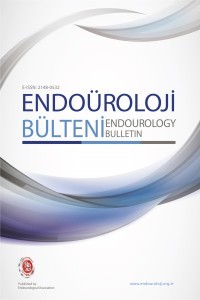Perkütan Nefrolitotomi’de Skorlama Sistemlerinin Cerrahi Başarıyı Öngörmedeki Yeri: Tek Merkez Sonuçları
CROES nomogramı, Guy’s skoru, perkütan nefrolitotomi, S.T.O.N.E skoru, taşsızlık
The Role of Scoring Systems in Predicting Surgical Success in Percutaneous Nephrolithotomy: Results from a Single Center
___
- 1. Yıldırım Ç, Salman MY, Yavuz A, Bayar G. Individualized Management of 1-2 cm Kidney Stones in the Lower Pole Calyces. Grand J Urol. 2023;3:42-48. https://doi.org/10.5505/gju.2023.70883
- 2. de Souza Melo PA, Vicentini FC, Beraldi AA, Hisano M, Murta CB, de Almeida Claro JF. Outcomes of more than 1 000 percutaneous nephrolithotomies and validation of Guy’s stone score. BJU Int. 2018;121:640-646. https://doi.org/10.1111/bju.14129
- 3. De La Rosette J, Assimos D, Desai M, et al. The clinical research office of the endourological society percutaneous nephrolithotomy global study: Indications, complications, and outcomes in 5803 patients. J Endourol. 2011;25:11-17. https://doi.org/10.1089/end.2010.0424
- 4. Thomas K, Smith NC, Hegarty N, Glass JM. The guy’s stone score-grading the complexity of percutaneous nephrolithotomy procedures. Urology. 2011;78:277-281. https://doi.org/10.1016/j.urology.2010.12.026
- 5. Okhunov Z, Friedlander JI, George AK, et al. S.T.O.N.E. nephrolithometry: Novel surgical classification system for kidney calculi. Urology. 2013;81:1154-1160. https://doi.org/10.1016/j.urology.2012.10.083
- 6. Smith A, Averch TD, Shahrour K, et al. A nephrolithometric nomogram to predict treatment success of percutaneous nephrolithotomy. J Urol. 2013;190:149-156. https://doi.org/10.1016/j.juro.2013.01.047
- 7. Withington J, Armitage J, Finch W, Wiseman O, Glass J, Burgess N. Assessment of Stone Complexity for PCNL: A Systematic Review of the Literature, How Best Can We Record Stone Complexity in PCNL? J Endourol. 2016;30:13-23. https://doi.org/10.1089/end.2015.0278
- 8. Tiselius HG, Andersson A. Stone burden in an average Swedish population of stone formers requiring active stone removal: How can the stone size be estimated in the clinical routine? Eur Urol. 2003;43:275-281. https://doi.org/10.1016/S0302-2838(03)00006-X
- 9. Vernez SL, Okhunov Z, Motamedinia P, Bird V, Okeke Z, Smith A. Nephrolithometric Scoring Systems to Predict Outcomes of Percutaneous Nephrolithotomy. Rev Urol. 2016;18:15-27
- 10. Ingimarsson JP, Dagrosa LM, Hyams ES, Pais VM. External validation of a preoperative renal stone grading system: Reproducibility and inter-rater concordance of the Guy’s stone score using preoperative computed tomography and rigorous postoperative stone-free criteria. Urology. 2014;83:45-49. https://doi.org/10.1016/j.urology.2013.09.008
- 11. Vicentini FC, Serzedello FR, Thomas K, et al. What is the quickest scoring system to predict percutaneous nephrolithotomy outcomes? A comparative study among S.T.O.N.E score, Guy’s Stone Score and CROES nomogram. Int Braz J Uro.l 2017;43:1102-1109. https://doi.org/10.1590/S1677-5538.IBJU.2016.0586
- 12. Farhan M, Nazim SM, Salam B, Ather MH. Prospective evaluation of outcome of percutaneous nephrolithotomy using the “STONE” nephrolithometry score: A single-centre experience. Arab J Urol. 2015;13:264-269. https://doi.org/10.1016/j.aju.2015.07.006
- 13. Akhavein A, Henriksen C, Syed J, Bird VG. Prediction of single procedure success rate using S.T.O.N.E. nephrolithometry surgical classification system with strict criteria for surgical outcome. Urology. 2015;85:69-73. https://doi.org/10.1016/j.urology.2014.09.010
- 14. Danis E, Polat EC, Bozkurt M, et al. Application of S.T.O.N.E. Nephrolithometry Score for Prediction of Stone-Free Status and Complication Rates in Patients Who Underwent Percutaneous Nephrolitotomy for Renal Stone. J Laparoendosc Adv Surg Tech. 2022;32:372-377. https://doi.org/10.1089/lap.2021.0197
- 15. Sfoungaristos S, Gofrit ON, Yutkin V, Landau EH, Pode D, Duvdevani M. External Validation of CROES Nephrolithometry as a Preoperative Predictive System for Percutaneous Nephrolithotomy Outcomes. J Urol. 2016;195:372-376. https://doi.org/10.1016/j.juro.2015.08.079
- 16. Singla A, Khattar N, Nayyar R, Mehra S, Goel H, Sood R. How practical is the application of percutaneous nephrolithotomy scoring systems? Prospective study comparing Guy’s Stone Score, S.T.O.N.E. score and the Clinical Research Office of the Endourological Society (CROES) nomogram. Arab J Urol. 2017;15:7-16. https://doi.org/10.1016/j.aju.2016.11.005
- 17. Labadie K, Okhunov Z, Akhavein A, et al. Evaluation and Comparison of Urolithiasis Scoring Systems Used in Percutaneous Kidney Stone Surgery. J Urol. 2015;193:154-159. https://doi.org/10.1016/j.juro.2014.07.104
- 18. Ozgor F, Yanaral F, Savun M, Ozdemir H, Sarilar O, Binbay M. Comparison of STONE, CROES and Guy’s nephrolithometry scoring systems for predicting stone-free status and complication rates after percutaneous nephrolithotomy in obese patients. Urolithiasis. 2018;46:471-477. https://doi.org/10.1007/s00240-017-1003-0
- Yayın Aralığı: 3
- Başlangıç: 2020
- Yayıncı: Pera Yayıncılık
Robot Yardımlı Böbrek Naklinde Bifazlı Sıvı Tedavisi’nin Etkinliği
Burhan COŞKUN, Halit Mustafa ACAR, Ahmet Eren TOTO, Gökhan OCAKOĞLU, Omer Faruk ASLAN, Onur KAYGİSİZ
Genital Siğillerin Erkeklerin Depresyonu ve Cinsel İşlevleri Üzerindeki Etkisi
Üreter Taşlarında Üreterorenoskopik Holmiyum: YAG Lazer Litotripsi Etkinliğini Etkileyen Faktörler
Genç Yaşta Görülen Transizyonel Hücreli Mesane Karsinomunda Genetik Yatkınlık Var Mıdır?
Selim TAŞ, Ali Erhan EREN, Mahmut Taha ÖLÇÜCÜ, Barış PAKSOY, Ekrem İSLAMOĞLU, Mehmet Salih BOĞA
Burhan COŞKUN, Sezin TÜRK KAYA, Yavuz Mert AYDIN, İsmail İFŞA, Seniha GÜNDÜZ, Hakan KILIÇARSLAN
Kompleks Üst Üriner Sistem Taş Tedavisinde Robotik Cerrahinin Rolü: Tek Merkez Deneyimi
